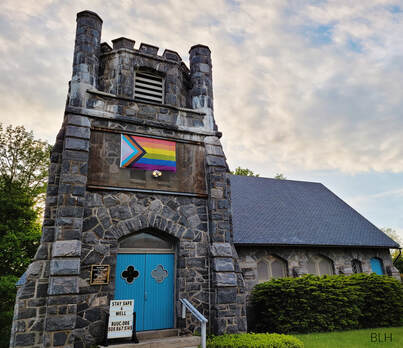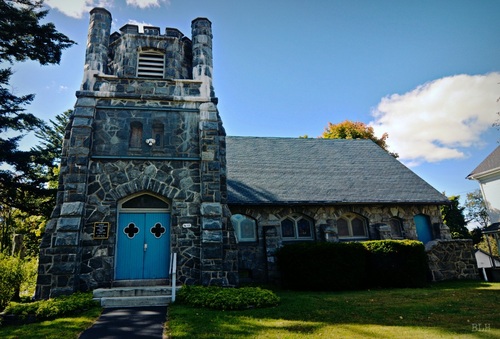BROOKFIELD UNITARIAN UNIVERSALIST CHURCH
A BRIEF HISTORY OF THE BUUC
The “Little Stone Church That Rocks” has a long and colorful history.
The first meeting house was located in the area of what English colonists named the Quaboag Plantation, when they arrived from coastal Ipswich to settle in 1660. The name was borrowed from the local, Indigenous people who lived in the area. The first meeting house was built on what is currently known as Foster’s Hill, bordering today’s towns of West Brookfield and Brookfield.
Tensions in the Massachusetts Colony between the English and Wampanoag People of Eastern Massachusetts resulted in what is known as King Philip’s War, sweeping into Central Massachusetts in 1675. The original meeting house and settlement on Foster’s Hill was burned, and the area abandoned by the English for a time. By 1686 the English had resettled, and for some 30 years services were held at the fortified building known as Gilbert’s Fort.
The second meeting house was built on the same site as the original building on Foster’s Hill @ 1715-1716. In 1716, the first settled minister, Mr. Thomas Cheney, was invited to lead the church, and in 1717 the new meeting house was completed. This is the official beginning of our present day congregation --1717. We go back a long way.
The third meeting house was built in 1754. The citizens of Brookfield in 1754 in decided to build a new meeting house on what is now called Banister Hill and what we now call the Mall. No time was lost building the new meeting house. The parish voted to “tear down the old meeting house and use the material for enclosing and finishing the new.” The first service in the new church was held on September 15 (following the last service in the old church on September 8). There was no disruption in Sunday services. This fact appears in many different versions of our history (including Rev. Walsh’s 1905 pamphlet, which came from his 1904 sermon celebrating the church’s anniversary).
This third meeting house either burned or was torn down (reports vary) around 1835 and a fourth rebuilt in the same location in 1836. The first service in this meeting house was held in 1837.
In 1849, the building was moved to the site of the present stone church. In 1867 it was moved again after being sold to St. Mary’s parish. The building is now part of the Catholic Church located on Lincoln Street.
In 1868 the congregation built a fifth meeting house. It was the largest church in Brookfield and had two spires, one 137 feet and the other 90 feet. Unfortunately on a hot humid July day in 1911, lightning struck the taller steeple. The old pewter service, the piano, pictures, dishes, and table linens were saved but the church was a total loss with just the shell remaining.
The congregation recovered quickly. On Sunday, June 9, 1912, the new stone church (then called the First Parish Church) was dedicated. It was made of Monson granite after the old English style and cost $20,000. (Even though it is said that lightning does not strike the same place twice, they were taking no chances.) The new church was built by E.H. Cross Company and Alexander Eliot of Worcester. The interior woodwork was cypress and the furnishings were oak. The dedication sermon was delivered by the Reverend Samuel A. Elliot of Boston, president of the Unitarian Society. Three hundred people were present for the service.
(Details excerpted from Rev. Lynne Plumb’s 1999 sermon (with corrections), from The History of the First Parish Church by Rev. William L. Walsh in 1905, and an article by Donna Sullivan in the BUUC Newsletter in 2007). Further revised by Sarah Swift in 2021 to acknowledge that our church is located on land that is the traditional territory of the Quaboag People.
The “Little Stone Church That Rocks” has a long and colorful history.
The first meeting house was located in the area of what English colonists named the Quaboag Plantation, when they arrived from coastal Ipswich to settle in 1660. The name was borrowed from the local, Indigenous people who lived in the area. The first meeting house was built on what is currently known as Foster’s Hill, bordering today’s towns of West Brookfield and Brookfield.
Tensions in the Massachusetts Colony between the English and Wampanoag People of Eastern Massachusetts resulted in what is known as King Philip’s War, sweeping into Central Massachusetts in 1675. The original meeting house and settlement on Foster’s Hill was burned, and the area abandoned by the English for a time. By 1686 the English had resettled, and for some 30 years services were held at the fortified building known as Gilbert’s Fort.
The second meeting house was built on the same site as the original building on Foster’s Hill @ 1715-1716. In 1716, the first settled minister, Mr. Thomas Cheney, was invited to lead the church, and in 1717 the new meeting house was completed. This is the official beginning of our present day congregation --1717. We go back a long way.
The third meeting house was built in 1754. The citizens of Brookfield in 1754 in decided to build a new meeting house on what is now called Banister Hill and what we now call the Mall. No time was lost building the new meeting house. The parish voted to “tear down the old meeting house and use the material for enclosing and finishing the new.” The first service in the new church was held on September 15 (following the last service in the old church on September 8). There was no disruption in Sunday services. This fact appears in many different versions of our history (including Rev. Walsh’s 1905 pamphlet, which came from his 1904 sermon celebrating the church’s anniversary).
This third meeting house either burned or was torn down (reports vary) around 1835 and a fourth rebuilt in the same location in 1836. The first service in this meeting house was held in 1837.
In 1849, the building was moved to the site of the present stone church. In 1867 it was moved again after being sold to St. Mary’s parish. The building is now part of the Catholic Church located on Lincoln Street.
In 1868 the congregation built a fifth meeting house. It was the largest church in Brookfield and had two spires, one 137 feet and the other 90 feet. Unfortunately on a hot humid July day in 1911, lightning struck the taller steeple. The old pewter service, the piano, pictures, dishes, and table linens were saved but the church was a total loss with just the shell remaining.
The congregation recovered quickly. On Sunday, June 9, 1912, the new stone church (then called the First Parish Church) was dedicated. It was made of Monson granite after the old English style and cost $20,000. (Even though it is said that lightning does not strike the same place twice, they were taking no chances.) The new church was built by E.H. Cross Company and Alexander Eliot of Worcester. The interior woodwork was cypress and the furnishings were oak. The dedication sermon was delivered by the Reverend Samuel A. Elliot of Boston, president of the Unitarian Society. Three hundred people were present for the service.
(Details excerpted from Rev. Lynne Plumb’s 1999 sermon (with corrections), from The History of the First Parish Church by Rev. William L. Walsh in 1905, and an article by Donna Sullivan in the BUUC Newsletter in 2007). Further revised by Sarah Swift in 2021 to acknowledge that our church is located on land that is the traditional territory of the Quaboag People.
Proudly powered by Weebly

